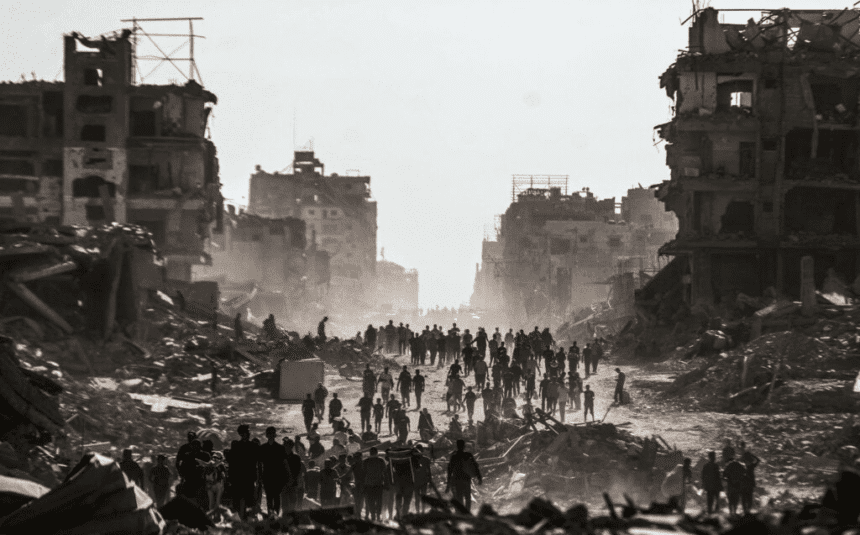“I wish I hadn’t come back” was the first thing Emad Azzam, one of hundreds of thousands of people who returned to Gaza City, said when Mada Masr spoke to him.
Palestinians started returning to northern Gaza after a new ceasefire went into effect on 10 October. Aerial photos showed thousands of people walking northward on the strip’s coastal road.
But for Azzam and countless others, the return to the once thriving metropole has been a return to homes that are a trace of what they once were, as, since mid-August, Israel has intentionally razed most of the city’s north, east and southern neighborhoods to the ground in controlled demolitions and bombardment.
When Azzam came to where his house had once stood, all he found “was a pile of rubble,” he told Mada Masr.
Despite the scenes of return, both triumphant and tragic, many Palestinians who have been displaced in recent months cannot or do not want to return. Israeli troops are still stationed in a majority of the coastal enclave, the Occupation has threatened anyone who comes near designated military zones, and the scale of known destruction has made the journey back futile for some.
Azzam was forcibly displaced from his North Gaza City neighborhood, Sheikh Radwan, when Israeli troops began to move into the surrounding streets in September. It was the second time he had been displaced since the war began two years ago.
“The second displacement was much harder than the first,” Azzam said. “We struggled to collect the money needed [to go south], and it was a struggle to leave our home once again.”
He and his family gathered their belongings and moved about 20 kilometers south. Like countless others, they had to make due in overcrowded, underserviced Khan Younis. As soon as the ceasefire began, they packed up, with little regard for the expense of returning.
“We were counting the hours and minutes until our return, hoping to find our home still standing,” he continued. “I couldn’t help but hope.”
But Azzam knew that this hope flew in the face of reason. For he was aware that Israel’s military had spent weeks using controlled explosives to destroy homes and shops, block by block.
“I knew deep down that my home and my family’s home had been destroyed,” Azzam said after seeing the rubble that his home had become.
For some, conditions were less desolate. Saady Mhanna returned alone to check on his family’s home in Tal al-Hawa, further south in the city.
“I found most of the house destroyed,” he told Mada Masr, “But thank God, part of it could be repaired so we can live there until reconstruction begins.”
He told Mada Masr he plans to go back to Khan Younis to bring his family home.
The degree of damage that the city, once home to a million people, has incurred, is difficult to calculate. But Mahmoud Basal, Gaza’s Civil Defense Agency spokesperson, estimated that most of the city’s north, east and southern neighborhoods are almost completely destroyed. Basal told Mada Masr that the campaign that began in mid-August has razed tens of thousands of homes to the ground.
The United Nations has said that a preliminary analysis shows that 83 percent of structures — about 81,000 housing units — in Gaza City have been damaged.
For those who have returned to find rubble, the resources for shelter and survival in the north are also scarce.
Basal, who estimated that around 300,000 people have already made the journey back northward, said there is nowhere to stay. There are currently no tents or temporary housing units available, he said, as the Israeli military has not yet allowed enough tents or prefabricated houses through the crossings.
Gaza City residents trying to leave the city amid Israel’s operation had to raise funds to buy tents for a minimum of US$1,000 each, in addition to hundreds of dollars per month in rent for land to pitch it on.
A leaked text of the ceasefire agreement states that aid provision was due to commence on Friday, when the ceasefire came into effect, in quantities equal to those established under the short-lived January ceasefire.
The UN has said that 600 trucks should be entering the strip daily to provide sufficient food aid to the 2 million people who need it and urgent care to around 200,000 people suffering from malnutrition.
There are even more people who have not returned at all. The family of Um al-Abd al-Hamalawy haven’t left their tent in the Zuwayda area west of central Gaza. “Our homes in Jabalia camp in the north are destroyed, and there’s no place to rent,” Hamalawy said.
Hamalawy described the idea of going back as futile: “We walk on foot from the south to the north, just to see the ruins of our homes and our lives.”
Thousands more Palestinians are unable to inspect their homes. The Israeli military is still deployed in a majority of the strip. Its forces are still barring residents of Beit Hanoun, Beit Lahia and Shujaiya from returning to or approaching their homes.
Ahead of the ceasefire going into effect, US President Donald Trump publisheda map with “an initial withdrawal line” marked in yellow. According to the Israeli media, the Occupation military has begun withdrawing in accordance with the map.
The plan discussed in Sharm el-Sheikh was to see Israeli troops withdraw from around 35 percent of the 85 percent of Gaza they were occupying only after the first phase of the prisoner exchange where Hamas is due to hand over around 20 living prisoners and an unknown number of bodies.
The withdrawal will allow Hamas to gather the remains of Israeli prisoners who had been killed during the two-year war, an Egyptian official told Mada Masr last week.
In the south, Israel’s military has threatened residents who approach areas that it has designated as “troop concentration points” in Khan Younis or near the Rafah crossing and Philadelphi Corridor.
Since March 18, when a ceasefire implemented earlier this year collapsed, over 1.2 million people in total have been displaced, according to the UN.
And while Trump’s son-in-law and advisor Jared Kushner celebrated the “end of the war” in remarks from Tel Aviv on Saturday night, for many in Gaza, it is not only that they doubt the ceasefire will hold.
“What war has stopped?” Hamlawy asked. “We’re living through a thousand wars. They took our lives and gave us a tent, and they want us to be joyous because they’ve stopped the killing and destruction.”
This article was originally published in Mada Masr and is republished here as part of the Progressive International Wire.
The post ‘The ruins of our homes and lives:’ Return to north Gaza fraught with loss for tens of thousands appeared first on Maktoob media.










